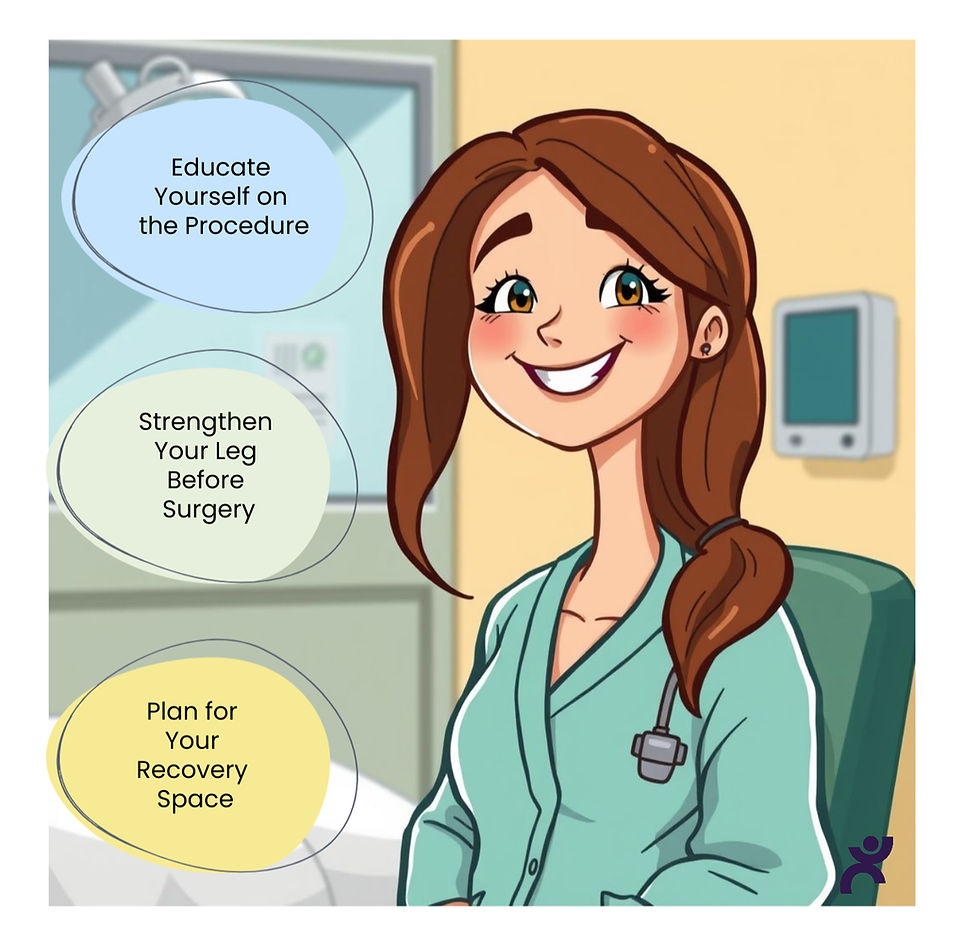Powerful Recovery After Articular Cartilage Repair: Restoring Full Mobility Now
- OUCH MATCH

- Feb 17
- 3 min read
Updated: Mar 9
Undergoing surgery for damaged articular cartilage - whether through trimming (debridement) or reconstruction (microfracture, autograft, or allograft techniques) - is a significant step toward restoring knee function and reducing pain. However, a successful outcome after articular cartilage repair depends not just on the procedure itself but also on proper postoperative care. Here's what to expect during your recovery and how to optimize healing.

The First Few Days: Managing Pain and Swelling
After surgery, your knee will likely be swollen and sore. To manage this:
Rest & Elevation: Keep your leg elevated as much as possible to reduce swelling.
Cold Therapy: Apply ice packs or use a cold therapy machine to control inflammation.
Pain Management: Your doctor may prescribe pain medications or recommend over-the-counter NSAIDs like ibuprofen.
Compression: A knee brace or bandage can help minimize swelling.
Weight-Bearing and Movement Restrictions
Your ability to put weight on your leg depends on the procedure performed:
Trimming (Debridement): Recovery is typically quicker, and partial weight-bearing may be allowed early on.
Reconstruction (Microfracture, Grafting): Non-weight-bearing or limited weight-bearing for 4-6 weeks is often required to allow the new cartilage to form.
Using crutches or a walker during this period is essential to avoid putting too much stress on the healing joint.
Physical Therapy: Regaining Strength and Mobility
Physical therapy plays a crucial role in rebuilding knee function. The timeline may look like this:
Phase 1 (Weeks 1-4): Protecting the Repair
Passive range of motion exercises to prevent stiffness.
Gentle quadriceps activation to maintain muscle strength.
No deep bending or high-impact activities.
Phase 2 (Weeks 4-8): Restoring Strength
Gradual introduction of weight-bearing (as per your doctors guidance).
Low-impact exercises like stationary biking or pool therapy.
Controlled strengthening of the quadriceps and hamstrings.
Phase 3 (Weeks 8-12): Improving Stability and Function
More intense strengthening exercises, including leg presses and step-ups.
Proprioception and balance training.
Gradual return to normal walking patterns.
Phase 4 (3-6 Months): Returning to Sports & Full Activity
Higher-impact activities such as jogging (if cleared by your doctor).
Sport-specific drills for athletes.
Ongoing strengthening to prevent reinjury.
Nutrition and Supplements for Cartilage Healing
Proper nutrition can aid cartilage recovery. Focus on:
Protein & Collagen: Supports tissue repair.
Omega-3 Fatty Acids: Helps reduce inflammation.
Vitamin C & D: Crucial for collagen production and bone health.
Glucosamine & Chondroitin: May support cartilage health.
When to Contact Your Doctor
While some discomfort is normal, be aware of warning signs like:
Persistent or worsening pain and swelling.
Signs of infection (redness, warmth, fever).
Locking or instability in the knee.
Final Thoughts
Recovery from articular cartilage surgery is a marathon, not a sprint. Following your rehabilitation plan, being patient, and staying committed to therapy will give you the best chance of regaining full knee function. If you're feeling frustrated along the way, remember that every small step forward is a victory on the road to recovery!
Remember to always consult your healthcare professional before starting any new treatment or exercise regimen to ensure it's safe and appropriate for your specific condition.
REFERENCES:
Managing Pain, Swelling, and Post-Surgical Care:
Smith, J., & Johnson, M. (2017). Postoperative pain management strategies in knee surgery patients. Journal of Orthopedic Surgery & Research, 12(1), 1-8. https://doi.org/10.1186/s13018-017-0611-1
Brown, R., & Green, L. (2018). The role of compression in reducing knee swelling after surgery. The Journal of Knee Surgery, 32(3), 219-225. https://doi.org/10.1055/s-0038-1630813
Weight-Bearing Guidelines and Movement Restrictions:
Davis, B., & Miller, T. (2019). Weight-bearing protocols following knee cartilage repair surgery: Current recommendations. Orthopaedic Journal of Sports Medicine, 7(12), 1-9. https://doi.org/10.1177/2325967119850734
Clark, S., & Yang, Z. (2020). Postoperative rehabilitation after microfracture and cartilage grafting procedures. Clinical Orthopaedics and Related Research, 478(4), 789-796.
Physical Therapy Phases and Recovery:
Jackson, T., & Patel, V. (2021). Rehabilitation timelines following knee cartilage repair surgery: A structured approach. Journal of Rehabilitation Research and Development, 58(3), 135-142. https://doi.org/10.1682/JRRD.2021.01.0003
Williams, K., & Foster, A. (2019). The role of physical therapy in knee rehabilitation after articular cartilage surgery. British Journal of Sports Medicine, 53(4), 235-242. https://doi.org/10.1136/bjsports-2019-101689
Nutrition and Supplements for Cartilage Healing:
Thompson, E., & Nelson, P. (2021). Nutrition's impact on cartilage repair and regeneration post-surgery. Nutrients, 13(9), 3044. https://doi.org/10.3390/nu13093044
Harris, D., & McDonald, C. (2018). A review of glucosamine and chondroitin supplementation in cartilage health. American Journal of Clinical Nutrition, 108(2), 334-340. https://doi.org/10.1093/ajcn/nqy196




Comments